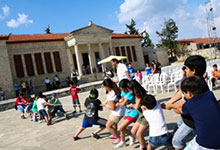
The customs of each country or village is one of the most important elements that keeps are traditions and our history alive in our minds. Some of these customs survived through time and some others exist only in our memories.
Christmas
Some days before Christmas, the inhabitants of Vyzakia start preparing for the big feast.
The preparations mainly include cleaning of the entire house and the yard, painting of the external and internal walls, dusting etc.
On Christmas day, people go to church. After the service they receive communion and then they exchange wishes and kisses. Thereafter, they return to their homes and the entire family sits on the table for the traditional soup “avgolemoni” (made with eggs, lemon and rice) or trachana (traditional soup), in a pleasant environment.
New Year’s Day
On 31st December the housewives put a wreath olive leaves on the door of their house. They also bake the “vasilopita” which is a large traditional cake with a coin in it. The person who finds it is considered the luckiest person of the New Year.
On New Year’s night the owner of the house places a candle, a plate full of “kollyva” and a glass of wine for the Santa Clause. He also places a wallet on the table because they believed that the Santa Clause would bless it and fill it with money.
On New Year’s Day People go to church to attend to the service and when it is finished they exchange kisses and wishes.
When they return to their homes they step in with their right foot because they believed that this would bring them luck.
Lent Period
The Lent period begins on the Sunday of the Prodian Son and continues till the Sunday of “Tyrofagos” (last day of the Carnival). Usually, during this period, a lot of people masqueraded and went to friendly houses where they amused the owners. They put swings for the girl and some others played games, for example they hanged a raw egg on the roof and tried to grab it with their mouth. The housewives don’t clean the table that night. They leave everything till the next morning because they believed that otherwise something bad would happen to the owner of the house.
Easter
(a) Palm Sunday
On Palm Sunday, women took leaves from olive trees to the church. The leaves would remain in the church until Pentecost when they would be hallowed and taken back home for the traditional “kapnisma” (literally smoking). Specifically, the leaves from the olive tree were put in the “kapnistiri” (earthen-plated vessel) with cinder and used for the “kapnisma” of the houses and people. This practice is considered as apostrophic for the evil spirits and it survives to this day.
(b) Holy Week
On Holy Thursday the villagers go to church to attend to the service of the 12 Gospels concerning the Passion of Christ, His Crucifixion and His death. All the inhabitants go to church and offer flowers and wreath.
On Holy Friday young women chant the dirge (lamentation), while some myrrh-bearing women strew the epitaph with myrrh, aromas and flowers (lilies). Four soldiers stand around the epitaph to protect it. Thereafter, some men carry it on their shoulders and walk around the village. Then, all the people worship the epitaph and take one flower each.
Some days before the Resurrection, the housewives bake their traditional rusks and flaounes and on Holy Saturday they baked the eggs and dyed them red.
Resurrection
On Saturday morning, the bells toll merrily in order to invite the Christians to the happiest service of the Christian church. The priest says “THE CHRIST HAS RISEN FROM HIS TOMB” and everyone in the church knock on their stools and take off the black veils which covered the holy icons.
On Saturday night, some minutes before midnight the bells toll and send the message for the Resurrection of Christ. Outside of the church there is a big fire, called “Lampratzia” (eastern bonfire). At midnight the priest says “ defte lavete fos ek tou anesperou fotos” (come forward and receive light from the eternal light) and comes out of the church with the lay clerks for the Procession. People light their candles from the holy light and they all go in the yard of the church for the Resurrection Ceremony.
Then, people return to their homes. They eat the traditional soup “avgolemoni” (made with eggs, lemon and rice) or trachana, flaounes and they clink the red eggs wishing each other “Christos Anesti” (The Christ has risen) “Alithos Anesti” (truly He is raised).
On Sunday, they make the traditional lamb on charcoals and they celebrate the day with dance and songs.
In the afternoon, the Community Council organizes some events (including traditional games) in the village’s plaza. The events continue until Easter Tuesday.






